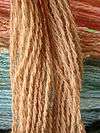Lumi (company)
 | |
| Founded | 2009 |
|---|---|
| Founder |
Jesse Genet Stephan Ango |
| Headquarters | Los Angeles, California, United States |
| Website |
www |
Lumi is a Los Angeles-based company founded by Jesse Genet and Stephan Ango that manufactures packaging and branded supplies. The company got its start developing Inkodye, a photo-reactive vat dye that develops its color through exposure to UV or sunlight.
History
Jesse Genet began experimenting with different printing techniques as a teenager in 2004, attempting to print photographs on cotton T-shirts.[1] Unsatisfied with the results of screen printing and dye-sublimation she pursued her research and found what became a precursor to Inkodye, a chemical formula from the 1950s owned by a retired engineer.[1] After meeting Stephan Ango while studying at Art Center College of Design, the pair acquired the chemical formula and began modernizing it.[2]
Lumi launched a Kickstarter campaign in December 2009[3] to fund R&D of the technology. The company raised $13,597 and rewarded its backers with wallets, bags and other products printed using the process. The project was an early success for the Kickstarter platform[4][1] and went on to win Kickstarter's Best Design Project of 2010.[5] In June 2012, Lumi launched a second Kickstarter campaign[6] with an initial fundraising target of $50,000 to commercialize its printing process, Inkodye. The project was successfully funded reaching over 500% of the initial target and raising a total of $268,437. Rewards included Inkodye printing kits allowing users to create personalized photographic prints on cotton and other natural materials. In February 2015, Lumi appeared on ABC's Shark Tank and received 2 offers, but Genet did not accept either of the offers.
In March 2015, Lumi announced its new software platform, Lumi.com, for designing and ordering custom-made packaging and branding tools such as rubber stamps. The service was funded by seed capital firm Y Combinator.[7] Lumi's platform was inspired by the challenges the company had faced in producing packaging for Inkodye.[8] The platform was compared to other services such as Blackbox by Cards Against Humanity and Make That Thing! by TopatoCo, provided by companies that also found success via Kickstarter and looked to simplify fulfillment and manufacturing for others.[9]
Inkodye Process
| Alternative photography |
|---|
 |
The process of printing with Inkodye resembles that of other alternative photographic processes though its chemistry is related to vat dyes such as indigo rather than iron or silver-based chemicals used in cyanotype or Van dyke brown which have higher toxicity. Inkodye is available in several colors (red, orange, copper, blue, navy, magenta, plum, sepia and black) which can be mixed together and diluted with water.
A monochromatic digital negative is first printed on transparency film generally using an inkjet printer with black ink only. The negative is made to be the same size as the final print. Inkodye is then applied to the desired T-shirt or fabric in its undeveloped state. The negative is placed on top of the sensitized fabric and exposed to sunlight or UV light. Exposure times vary from 3 to 15 minutes depending on the desired color and intensity of light.[10] The exposure to sunlight develops the dye's color and binds it to the fabric. The final step is to wash out the unexposed dye using a washing machine and laundry detergent.[11]
References
- 1 2 3 Fleishman, Glenn (2013-03-02). "Here comes the sun". The Economist. Retrieved 2013-06-04.
- ↑ Stone, Zak (2012-08-13). "Wearable Instagram: Can Two Designers Revolutionize Photo Printing?". GOOD. Retrieved 2013-06-04.
- ↑ Launched: Dec. 23, 2009 (2009-12-23). "Lumi Co. – A NEW TEXTILE PRINTING TECHNOLOGY — Kickstarter". Kickstarter.com. Retrieved 2013-06-04.
- ↑ Prentice, Claire (2010-05-12). "Cash-strapped entrepreneurs get creative". BBC News. Retrieved 2016-10-05.
- ↑ "Best Design Project » The Kickstarter Blog — Kickstarter". Kickstarter. 2011-01-12. Retrieved 2013-06-04.
- ↑ Launched: Jun. 30, 2012 (2012-06-30). "Print on Fabric Using Sunlight: The Lumi Process by Lumi — Kickstarter". Kickstarter.com. Retrieved 2013-06-04.
- ↑ Launched: Mar. 5, 2015 (2015-03-05). "YC-Backed Lumi Will Help You Customize Anything". Techcrunch.com. Retrieved 2015-03-27.
- ↑ Segran, Elizabeth (2016-09-26). "Meet Lumi, The Company That's Making Mailers The New Shopfronts". Fast Company (magazine). Retrieved 2016-10-05.
- ↑ Fleishman, Glenn (2016-09-26). "Warehouse On Demand". Fast Company (magazine). Retrieved 2016-10-05.
- ↑ Ray Laury, Jean (2010). Imagery on Fabric: A Complete Surface Design Handbook. C&T Publishing. pp. 122–123. ISBN 1-57120-034-7.
- ↑ Lhotka, Bonny Pierce (2013). The Last Layer: New methods in digital printing for photography, fine art, and mixed media. New Riders. pp. 185–202. ISBN 978-0321905406.
